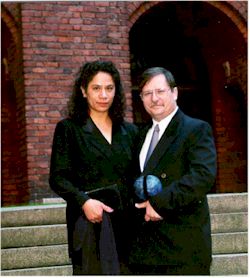|
|
|
Robert
Brown
Tapping
the Potential of the Internet for Learning

|
Robert and his wife Daphne, right after the award ceremony, on the steps of the hallowed Nobel Hall in Stockholm, Sweden, holding the glass trophy. |
Universal, free education. Tapping the potential of computer technology and the Internet for learning. Global access to information. Lifelong, independent learning.
These are all goals that educators recognise as laudable, but many of us do not know how to translale these goals into a practical means of delivering content. Robert Brian Brown, formerly a principal lecturer at the Central Institute of Technology (CIT) in New Zealand joined Abu Dhabi Women’s College as a CIP teacher in August of this year. Robert who holds a Masters in Communication (with Merit) from Victoria University, is an innovator in the field of Internet education.
When he was teaching at CIT in 1995, Robert decided to address a problem he had observed in his classes. There was a high failure rate amongst many of his returning students (especially those who were women with families), who were struggling in traditionally structured courses. In order to address this issue, Robert developed an alternate form of delivery. His courses in the form of a website, which can be found at http://www.cit.ac.nz/smac/csware.htm
At first, only interactive tests and lecture notes were placed online to compliment the ordinary course delivery. The students could access the site after hours, took at the lecture notes, note when assignments were due etc.. Gradually, this led to entire courses being offered online, providing education that was easily accessible, student oriented, on a self-paced and flexible timetable. This became known as the CIT's Lifelong Learning Site.
The response was astounding. Within three months of the web-site going on-line, it was the number 1 access site in all of New Zealand, averaging one million hits per week. In fact, Robert reports that when this information was first released to the press, CIT was accused of exaggerating their figures, and debate raged until CIT was able to satisfy the naysayers that the extraordinary number of users was accurate. In addition. Robert received feedback on the courses and the website from people of all ages and backgrounds ail over the world - over 600 e-mails per day!
The unaccredited courses offered on this website were exactly the same as those accredited courses offered by CIT, but geared to independent learning, targeting those people who would not normally enrol in a traditionally-structured university course - In response to the feedback he had received from students and educators who had accessed the site, the site was made more accessible to students with disabilities, the site was made more student-oriented, and chat rooms were added.
While access to the website is free, CIT decided to produce the same information on CD-ROM for sale to universities around the world. Even though the information is freely available on the Web. Sales of the CD-ROM are very strong.
Robert sees enormous potential in the use of educational technology as a "vital piece of the educational jigsaw." The true power of technology is its ability to deliver a variety of learning styles and techniques, allowing those students who might not excel in a classroom to excel in an online environment. He sees a time in the future when accredited courses will be available for free online, truly making education universally accessible. He states that the lesson to be learned is that there is a huge market potential for educational delivery using the Internet; its goals are not about accredited qualifications, but about learning and access to education.
In 1999, the CIT Lifelong Learning Site was nominated for the prestigious Global Bangemann Challenge in the category of "lifelong learning." Robert travelled to Stockholm, Sweden, knowing only that he was one of five finalists in his category, and aware of the high calibre of other entries. The website won the award, which was presented by the King of Sweden, and which Robert describes as the "America's Cup of IT." Judges told him the CIT entry won because it was global in scope, focusing on educating people anywhere in the world rather than in one community of interest.
As the recipient of this award, Robert has now been invited to be a member of the international jury of the Global Youth Challenge to be held in Rome, in December. This is an international competition for websites designed by young people up to the age of 29. These sites must have local, cultural as well as global aspects, and must provide some sort of benefit to the community. Robert hopes that the Abu Dhabi Women's College will be a competitor in next years' challenge; he thinks that projects such as the Corniche Chronicle and the Desert Rose are of international quality and worthy of being submitted. Robert states, participation on the global stage will raise the international profile of the HCT and demonstrate the excellence of its students.
With innovators such as Robert, the HCT stand to be in the forefront of achieving the goal of tapping the potential of computer technology and the Internet for learning.
Jean Fitzgerald, ADWC
Al Rawi, Higher Colleges
of Technology
Volume 8, Issue 2, November 2000